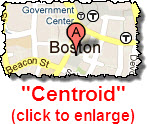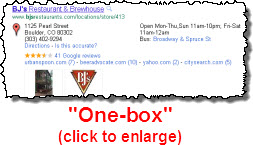 Fine, so maybe it’s not yet a book of Google Places slang. But “book” just sounds better than “compendium.”
Fine, so maybe it’s not yet a book of Google Places slang. But “book” just sounds better than “compendium.”
Whatever you want to call it, I’ve written it for two purposes:
Purpose 1: To show that we Google Places visibility specialists aren’t just a bunch of geeks: We have our own culture—even our own language! I’d like to take you on a cross-cultural adventure, to allow you to bask in the richness of another language, and…eh, who am I kidding. The real point of it is:
Purpose 2: To clarify what these terms mean. Some Google Placers (should that be a new slang term?) use this specialized slang more than others do. Maybe you’ve checked some of their blogs, articles, or videos. Much of it is excellent stuff, but the slang can occasionally hold you up—especially if you don’t spend all day grappling with Google Places and its nomenclature.
In other words, I’d like to help make all the stuff that’s written by and for Google Places obsessives a little easier for you to digest and apply to your business, so that you can get more visible to local customers.
Some of these terms are pretty new (circa 2010-2011), whereas others have been around for a while.
By the way, this is NOT a glossary. I’m not going to define terms like “canonicalize.” You can look up technical jargon easily enough. I’m just dealing with the stuff that’s somewhat harder to look up.
In alphabetical order:
3-pack: When people type in a local search term and see 3 local businesses listed on the first page of Google Places, they’re seeing the “3-pack” local results. You typically see this in less-competitive markets, where there aren’t a ton of businesses competing with each other in the same local market. But they could become more common in the future: As I wrote back in June, Google seems to have tested 3-pack local search results on at least one occasion.
7-pack: That coveted list of 7 local businesses on the first page of Google Places. It’s where you want your business to rank and be seen when local customers type what you offer into Google.
10-pack: As you probably recall, you typically used to see 10 local businesses when you’d type in a local search term. But in April of 2010, Google chopped it down to just 7 local businesses that rank on the first page of local results. (That’s also when Google Places started being called “Google Places,” and no longer “Google Local Business Center.”)
Algo: Short for “algorithm.” As you probably know, this just refers to the giant, messy orgy of factors that Google weighs when determining how your business (and others) will rank.
Centroid: I know it sounds like something you take for an upset stomach, but it actually means the geographical center of a city or town, as defined by Google. How close your business is to your city’s “centroid” affects your ranking: all other things being equal, a business that’s located closer to downtown generally holds a ranking advantage over others. Some people used to think that the “centroid” was the location of the downtown USPS post office, but this wasn’t and isn’t true. Where’s the “centroid” of your city? To find out, type the name of your city into Google, click on the “Maps” tab at the top of the page, and zoom in: the “A” map pin marks what Google sees as the geographical center of your town.
Google Love: When the owner of a business / Google Places page sweeps Lady Algo off her feet by following her official guidelines, being a responsible category-picker, a sensitive citation-gatherer, a charming conversationalist, and someone who enjoys long walks on the beach. Said business owner is then invited upstairs—up to a higher local ranking, that is.
IYP: Short for “Internet Yellow Pages.” Any local-business directory sites, like Yelp, AngiesList, SuperPages, CitySearch, etc.
NAP: Stands for “Name, Address, Phone”—which itself isn’t particularly clear. It usually refers to the practice of including the name of your business, your business address, and your business phone number at the bottom of each page of your website. This info should appear as crawlable text (not as an image!) at the bottom of your webpages exactly as it appears on your Google Places listing—and with the same formatting. Even more info about NAP here.
One-box (also written “1-box”): Any time you type in a local search term or search for a specific business by name and see only ONE local-business result on the first page of Google, you’re looking at a “one-box.” It contains a website OR Google Places search-result for that business, the red Google Places map pin, links to the Places page, usually at least one photo that the business owner uploaded, and sometimes sitelinks. It also used to contain a little map, but I haven’t seen this recently. It’s excellent if your business shows up as a one-box when you type in a local-search term (rather than search for your business by name), but this isn’t likely to happen if you’re in a competitive local market.
Places Purgatory: When your Google Places listing supposedly is active, and should be highly visible in the search results, but instead is NOT—and for no apparent reason. You don’t know what (if anything) you’re doing wrong, and the Google Gods have not descended to tell you how you must change your ways. Mike Blumenthal describes Places Purgatory excellently.
Snippets: Before July 21 of 2011, Google would grab little excerpts of reviews and other info from third-party sites (see “IYPs,” above) and display them prominently on your Places page. The purpose of this was to supplement whatever info a business owner put on his or her own Places page with a bunch of info culled from other sites. Google has since removed these because of the whole antitrust case that’s been brewing.
—
I must have forgotten some terms. Which ones am I missing?
Leave a comment and hit me with your best slang suggestions (and even your definitions, if you’re feeling generous). If I like your slang, I’ll update this post to include it. Just don’t bother telling me technical jargon: I know it, and anyone who doesn’t can easily look it up.
By the way, if you’ve coined any Google Places-related terms, do let me know. Maybe this slangbook is where they’ll catch fire…


Great list I would only add “Blended Results” and “Citations”.
@Court
Thanks for your compliments! Yeah, I thought hard about including those two, but other people do a pretty good job of defining “citations” and “blended results,” and I think they’re more jargon than slang.
As I mentioned in the post…if you have any terms that you think ought to become GP slang, I’d love to hear ‘em
Thanks for the list, how about “descriptive terms” i.e. Google auto-generating keyword phrases on the listing which are frequently used to describe a business. Typically display right above the photo section.
@Julien
Ah, I didn’t even think of “descriptive terms.” Certainly a good term to know, and I don’t know what the hell Google calls them, so that’s a good descriptive term for the descriptive terms :). But not quite sure that we have a slang term for them just yet…
How about Oh, My Google! This would be a frequent swear word using the name of G____e in vain. Commonly happens when perfectly optimized listings show up on the second page with multiple unclaimed listings on the first page. Most commonly used when G____e changes the rules again.
Yeah, that’s a good one! My Google Places swear words of choice usually don’t start with the letter G, but I can appreciate the sentiment. Maybe you could write the 2011 Google Places Cuss Book!